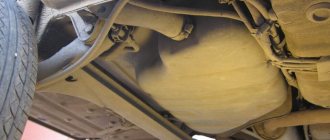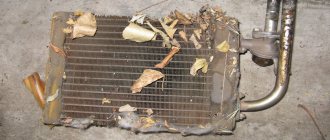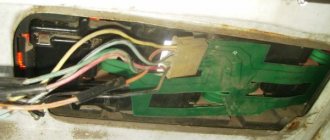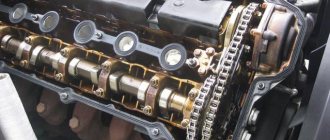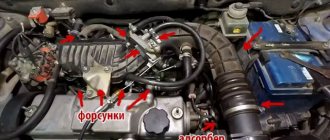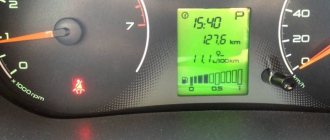Causes of the smell of gasoline
If the smell of fuel does not disappear even after several kilometers from the gas station, then the reason may be that the fuel tank cap is not sealed properly.
. Make sure it is in place, securely tightened, and in serviceable condition. Because when the rubber seal is cracked or dried out, it should be replaced.
The cover is ok and you drive on, but the smell still doesn't leave the car's interior? Check to see if your windows are closed, maybe the smell is coming from the exhaust pipe
(due to incomplete combustion of fuel). It can get into windows and the car ventilation system.
There are no problems with exhaust gases either, then inspect the bottom of the car, there may be a leak somewhere in the fuel line
. Leaks or leaks in the gas tank or fuel pipes occur due to a violation of the integrity and at the joints. A leak can be caused by corrosion (especially in metal tanks), and occurs due to mechanical damage or loosening of the clamp attached to the pipes.
In addition to these three main problems, there may of course be others, but much less frequently. However, so that you can check, because perhaps this is exactly your case, I will list a few more possible situations:
The absorber filter is clogged, there is a crack between the neck and the tank, the fuel supply is disrupted (carburetor failure or injector failure).
Where does gasoline come from in the cabin?
The cause of the smell is gasoline fumes penetrating into the cabin. There are more than enough ways for them to get in - the car interior has many ventilation holes. The success in troubleshooting and troubleshooting largely depends on determining where vapors penetrate into the cabin.
There are 2 main reasons why the smell of gasoline occurs:
- Fuel system malfunction. It consists of many different components, damage to which not only causes a persistent gasoline smell both inside and outside the car, but can also cause a fire.
- Exhaust system malfunction. Exhaust gases entering the cabin may also have a strong gasoline odor.
In any case, if such aromas occur, it is necessary to urgently begin to identify the malfunction. It is worth noting that gasoline vapors are poisonous, and their inhalation provokes a decrease in reaction and hallucinations. The manifestation of symptoms of poisoning in a car driver can cause a serious accident.
Save the people, it smells like gasoline
In general, this morning I noticed that there was a completely unnoticeable smell of gasoline in the cabin.
I drove all day...on the wretched roads of Churkin (I hit the bottom of the car a couple of times, but only slightly) But in the evening, when I parked the car, I discovered that in the area of the rear wheel arch (on the left) there was a terrible stench of gasoline, as if the entire wheel and arch were doused with it. The gas tank inlet is closed and there is no smell at all. There is also no smell from the other wheel arches, only from the rear left one. The car sat for about 2 hours, the smell remained insignificant at all. Someone said that it was a muffler - but the muffler is on the right, there is no smell of anything in the rear wheel arch on the right.Who thinks about this?
The smell of gasoline in the car interior - possible consequences
Cars VAZ-2101-2105, VAZ-2106 and VAZ-2107 are morally and technically becoming obsolete, which allows us to safely classify them as “classics”. And, despite knowledge of the design and maintenance experience, the problem with the smell of gasoline in the interior of such cars is becoming more and more common.
Injection models are also not left out, the fuel system of which is also far from ideal.
Before considering the reasons for the smell of gasoline, we will analyze the likely risks and consequences of such a malfunction.
There are several of them:
- INCREASED FUEL CONSUMPTION. Often the appearance of odor is associated with a leak in one of the elements of the fuel system. As a result, most of the gasoline will remain on the asphalt or elements of the car body.
- RISK OF FIRE. The main danger of fuel is its tendency to ignite. A small spark is enough for the gasoline vapor to ignite along with the car. There is no need to remind you about the consequences again.
- HARM TO THE BODY. Gasoline vapors, despite their pleasant aroma, are dangerous to the respiratory system and the body as a whole. Prolonged inhalation of fuel vapors leads to dizziness, nausea and even loss of consciousness. In addition, long-term exposure to vapors may result in poor health and even death.
That is why, when the first smell of gasoline appears, you should act without delay, regardless of the make of the car - be it Lanos, VAZ-2107, Niva and other cars.
The car smells like burnt rubber: 3 reasons
After heavy use, did the brakes and clutch burn out on a car with a manual transmission? As a result, the car smells like burnt rubber.
This also happens because the driver has been driving for a long time on the brakes or with the handbrake raised. If the brake pads are stuck, you may also experience a pungent, pungent smell of burnt rubber.
Reason #1: Burnt out brakes.
It's easy to find out why your car smells like burnt rubber. Have you noticed that after a long trip there is a foreign smell in the cabin? Park and check your brake discs
To do this, you need to carefully touch them with your palm and check the temperature.
Note! If the problem is the brake rotors, they will be hot enough to burn you, so be careful. Did you find out that one drive is hotter than the others? This means that it is in this wheel that the brakes are burning... If you sniff, you will feel that the smell of burnt rubber is coming from under this wheel
It is necessary to raise the car on a lift or with a jack. Then you should spin the wheel, while the brakes and handbrake should be lowered. Is the wheel difficult to turn? This indicates that there is some kind of malfunction in the pads.
If you sniff, you will smell the smell of burnt rubber coming from under this wheel. It is necessary to raise the car on a lift or with a jack. Then you should spin the wheel, while the brakes and handbrake should be lowered. Is the wheel difficult to turn? This indicates that there is some kind of malfunction in the pads.
If you don't visit a car repair shop soon to fix the problem, your brake pads will wear out quickly. And this is provided that the brakes are slightly overheated.
However, the consequences can be much more serious. For example, the effectiveness of the brakes will decrease: the brake hoses will burn out. As a result, fluid will leak. The brake discs will move. If this happens, you will notice vibration when you brake.
Reason No. 2. Burnt out clutch.
If the clutch is burnt, the car will also smell like burnt rubber. In this case, the smell will be even more pungent.
When the clutch burns out, and not the brakes, the smell of burnt rubber is strongest in the car interior. The appearance of a burnt rubber smell indicates that the clutch is slipping, is badly worn, or needs adjustment.
If a system with hydraulic couplings experiences clutch slipping, the hydraulic system is faulty.
How do you know if the clutch is burnt out? To do this, you need to go to a service station, where specialists will check the clutch and identify any faults.
If the fault is not corrected, the clutch will finally wear out, and in any case you will go to a service station, but now in order to replace the failed unit.
Reason No. 3. Overheated rubber.
Have you noticed that your car smells like burnt rubber after you brake at high speed or skid on the asphalt? In this situation, the smell comes from the tires. Wait 2-3 minutes, the wheels will cool down and the unpleasant smell will disappear.
Leaks under the hood
Gasoline leaks under the hood are already a dangerous breakdown, and until it is found and fixed, it is better not to start the engine at all. Who knows how much fuel spilled there, and where it ended up after that. A “light” that can “light” highly flammable gasoline vapors under the hood can be found at the generator, at the starter, and at the exhaust manifold.
As a rule, if the car is relatively new, the entire engine compartment fuel system is visible. To look for leaks, carefully inspect the lines and fuel filter. Gasoline especially “likes” to leak at the junctions of the pipes and fittings.
Attention! It is likely that with the engine turned off (the gasoline pump not working), you will not see any obvious leakage. Perhaps it manifests itself when pressure is created in the lines. If you suspect this reason, it is better to contact a professional. As a last resort (if your hands are itchy or there is no fear), start the engine for a short period of time and do not forget to re-read the same highlighted block above. As a rule, if there is a leak under pressure, it will quickly manifest itself. Immediately turn off the engine and only then eliminate the “weak link”.
In modern cars, finding fuel leaks under the hood is a little more difficult. At the very least, to do this you will have to remove the decorative cover and, perhaps, arm yourself with a good flashlight. While you are looking for a leak, take a sniff. Gasoline is such an infection - it gives itself away with its smell quite easily.
Under-hood problems also include fuel injectors, but more on them a little later.
Why does it smell like gasoline when starting the engine “cold” or “hot”?
Note that if the smell of gasoline is heard only for some time after starting the injection engine, then this is not a malfunction in all cases. Often, the smell of fuel appears after a cold start in winter, then completely disappears as the power unit warms up. If this is the case, then you need to understand the following:
- The ECU receives information from the engine temperature sensor, which “reports” that the unit is cold.
- Based on this information, the control unit enriches the mixture, significantly, and also increases the speed to the so-called “warm-up” speed.
- When operating with an over-enriched mixture in the cylinders of a cold engine, the fuel does not burn completely; some of it ends up in the exhaust system.
It turns out that the smell of unburned gasoline that the driver feels comes from the exhaust pipe. After the engine warms up slightly, the fuel will begin to burn more fully and the smell will disappear. This situation can be considered the norm for many cars.
However, in some cases it is also appropriate to talk about malfunctions, especially on modern cars that meet the Euro 4 standard and higher. The fact is that incomplete combustion of fuel can occur not only as a result of over-enrichment of the mixture by the ECU itself to maintain stable operation of the internal combustion engine after a cold start, but also for other reasons.
For example, problems with the ignition system, compression in the cylinder, mixture formation and a number of other problems will lead to the fact that the charge will burn incompletely even after the power plant has warmed up. At the same time, the engine begins to overuse fuel, stalls, loses throttle response and power, and smokes. In this case, the cause of the smell of gasoline, regardless of the temperature of the internal combustion engine, is a malfunction of the engine or its systems.
In other words, if gasoline smells “hot,” this clearly indicates incomplete combustion of the fuel. In such a situation, the unit requires in-depth diagnostics. Need to check
spark plug
,
spark plug wires
, ignition coils and other elements.
Also, the ECM sensors (mass air flow sensor, oxygen sensor, etc.) need to be checked, the condition of the air filter is assessed, the injection nozzles are diagnosed, the general tightness of the power system also needs to be checked for air contamination, and so on.
Let us also add that on injection engines, a common cause of the smell of gasoline is a violation of the tightness of the injection nozzles. The specified tightness is achieved through the installation of special sealing rings. Injector O-rings are rubber products that can become deformed and unusable over time.
Folk remedies for eliminating the smell of gasoline from your hands and car interior
Coffee
According to car owners and truckers, coffee is an ideal solution for eliminating the specific smell of gasoline or diesel fuel. The thing is that coffee contains oils that absorb extraneous odors, so it’s enough to pour ground coffee onto the problem area and remove it from there after a week.
Important! In general, you can use not only ground, but also freeze-dried coffee, while its cost does not matter, the main thing is the pronounced aroma
Lemon or citric acid
Another remedy that can be used to eliminate unpleasant odors is lemon (citric acid). Procedure:
- Add citric acid to a container of water (2 tablespoons per 1 liter of water).
- Treat problem areas.
- Spray the car interior with fresh lemon juice.
As for your hands, you can remove the smell of fuel from them by simply rubbing your hands with half a lemon. This method is not advisable to use if there are wounds on your hands.
Baking soda
A product that is used by housewives to solve any household problems is soda. In the case of gasoline, it will also give the desired result. To eliminate odor, simply follow the following procedure:
- Cover the stained area with baking soda.
- Wait 12 hours or more (up to 24 hours).
- Remove the substance with a vacuum cleaner.
- Wipe the surface with a damp cloth.
- Repeat if the aroma remains.
Important! You can also use caustic soda to eliminate the smell of gasoline, but in this case you need to wear rubber gloves, since the substance can cause chemical burns
Dishwashing liquid
Dishwasher detergent can be used to remove fuel odors from both your hands and the trunk or floor mats of your vehicle. The thing is that liquid chemical dishwashing detergents include components that break down fats. In addition, they contain aromatic components that will hide the unpleasant odor. You can remove the smell of gasoline from your hands by simply washing your hands with dishwashing liquid.
To clean the interior, you need to carry out the following procedure:
- Apply a little liquid to the problem area.
- Wait until the product is absorbed.
- Rinse with clean water.
Soap solution
If the car interior is made of leather, then you can remove the smell of fuel using a soap solution, applying it with a cotton swab to problem areas. The soapy residue needs to be rubbed a little and then washed off with water. This method is used both to eliminate odors from the interior and for hands (it is enough to hold them in a soap solution for 15-20 minutes).
Bleach and hydrogen peroxide
You can also use hydrogen peroxide to remove gasoline stains. To do this, just soak a cotton swab in the solution and wipe the surfaces. An alternative solution is to use professional bleaches, such as Vanish.
Table vinegar
In order to eliminate the smell of fuel from your hands, just mix the substance with warm water in a ratio of 1:2 and put your hands in the solution for 10-15 minutes. If we are talking about a stain in the car interior, then to do this we need to do the following:
- Remove floor mats stained with gasoline from the car.
- Mix vinegar and water in a 1:2 ratio and pour into a container with a spray bottle.
- Treat problem areas by spraying the solution on them.
- Air the rugs for 1-2 days.
Bread
You can also use bread to eliminate odor, cut into slices and spread on contaminated areas. Within a day, all foreign odors will disappear from the car interior.
Problems with the exhaust tract
The exhaust system of a car consists of several components:
- an exhaust manifold;
- "trousers";
- catalyst;
- resonator;
- muffler.
Depending on the car, there may also be different variations in the exhaust tract layout. They are connected to each other either by welding or by bolting. Special asbestos rings that are insensitive to high temperatures are used as gaskets.
If the exhaust system leaks, exhaust gases may enter the vehicle interior. Gases that smell strongly of gasoline indicate a malfunction of the ignition system. It leads to the fact that the fuel in the cylinders does not burn completely and ends up in the exhaust tract. Additional symptoms of this may include loss of car dynamics, unstable engine operation and increased fuel consumption.
How to get rid of water in the muffler
Green light on the battery (built-in indicator). what does it mean and why may it not light up?
Moisture should not actively accumulate inside the muffler. You can avoid its formation by following these recommendations:
- Increase the engine warm-up time if the engine has automatic warm-up. You can use a separate liquid heater if the muffler does not have time to heat up.
Do not leave your car outdoors in winter. Use quality fuel. The low grade is all water. Place the car at an angle with the front end down after starting the engine. This method will reduce the intensity of corrosion on metal walls. Insulate the muffler (especially important for cold areas). Any non-flammable heat insulator can be used.
It’s worth making long trips at least once every 30 days (preferably in winter or autumn). This will make it possible to warm up the car and its exhaust system well. An hour-long drive along the highway at high speeds is the best way to remove excess moisture from the silencer. Short trips around the city do not give such an effect. This, on the contrary, is a destructive factor - the condensate will only have time to thaw and turn into water.
Is it possible to drill the muffler?
You need to drill the resonator, not the muffler itself. A thin 3mm metal drill is placed on the drill. Up to 250 ml of water can leak from the exhaust cans. The method is imperfect, but quite safe. Some drivers even use it on new cars.
The manufacturer does not recommend making holes in the resonator. The metal of the muffler quickly becomes unusable after this, because even a small hole is a potential source of corrosion. Due to high temperatures and dirt, the process of rust spreading becomes more intense. In addition, a leaky muffler makes a lot of noise and exhaust gases enter the cabin.
Depressurization of the fuel tank
If you ask experienced car repairers, they will tell you that in 95% of cases the cause of the smell of gasoline in the cabin is the fuel tank. This is not strange, since this is where the most gasoline is constantly found. Finding a gas tank leak is not an easy task. “Good” if it turns out that fuel has begun to leak somewhere in the visible part. This problem is easy to find, although not very easy, but eliminated.
It’s a completely different matter when the “dog is buried” somewhere between the tank and the body of the car. In this place, the container is pressed tightly against the machine and, according to the manufacturers’ idea, should be motionless. To prevent metal from rubbing against metal, the tank and body are separated by gaskets made of a material that tends to deteriorate over the years. When such a moment comes, it is no wonder that a literal hole appears in the tank. This is where the cabin can smell of gasoline.
Attention! If you suspect that the gas tank is leaking, you should be careful when dismantling it. Due to the fact that this part is located, to put it mildly, where it is “damp,” the fastening elements turn out to be completely rusted. They are often cut down with a grinder, which can “light” the gasoline vapors so that mom doesn’t worry.
The relationship between the turned on stove and gasoline vapors
Another case: the smell of fuel penetrates into the cabin when the heater is on. The reasons are essentially the same: in some area the system is not working properly. The vapors evaporate, and the stove simply draws them inside the cabin, creating an unpleasant aroma. The first thing you need to do is pay attention to the presence of stains under the body, and then check the rubber hoses, especially at the places where they are connected with clamps. Metal does not age so often, but the rubber hoses that enter from the oil filter can become leaky quite quickly.
One more point worth paying attention to. Regardless of the specific reasons for the appearance of the aroma of gasoline inside the car, you need to remember that the fumes are toxic and unsafe for health. In addition, they are also flammable and flammable. Therefore, turning a blind eye to the existence of this problem is categorically not recommended. You shouldn’t be naive to think that the smell is a consequence of a recent refueling at a specialized station. In this case, it will disappear within 15-30 minutes and will not bother you. If this does not happen, it means there is a fuel leak somewhere in the system.
This will conclude today's discussion. We found out where the smell of fuel inside a car can come from, as well as the main ways to remove it so that it does not bother people in the cabin. And in order for the interior of your car to not only smell nice, but also look great, read the material on choosing a polish for the interior and how to restore the shine of chrome parts. There are many interesting publications ahead of us, which you risk missing if you do not join the number of our subscribers. Although, perhaps, you are already among them, and therefore will be notified about the release of new materials. See you!
How to eliminate the smell of gasoline
Despite the fact that there are many problems, there is only one sure remedy - to eliminate the source of the unpleasant fuel odor. But each type will have its own reliable method.
- If the cabin is filled with fumes, then only good ventilation will help, because various kinds of fragrances will only mask it.
- If fuel gets on your clothes or inside the cabin, soda will help. Sprinkle or rub the place where the gasoline ended up and within a day it will absorb all the smell.
- If there is a fuel leak, use a bar of soap.
- If a part is damaged, replace it with a new one.
Remember that detecting a gasoline odor requires taking emergency precautions. Because the smell of gasoline may indicate a more serious problem that could lead to a fire. Also, do not forget about your health and be attentive to detail.
The advice is useful - press THINGS UP. Very useful - share on social networks. If you have something to say, write a comment!
How to remove using improvised means?
You can cope with the smell of diesel fuel using available means. They come to the rescue if you don’t want to buy expensive store-bought formulations.
Dishwashing liquid
Dishwashing liquid is an excellent fat dissolver. It is effective even in cold water and is harmless to most fabrics.
Mode of application:
- Moisten the area of the item that needs treatment with water.
- Apply dishwashing gel to it and foam it with a sponge.
- Leave the product to act for 15 minutes.
- Wash the item in warm or hot water.
Gasoline Galosh
Surprisingly, the smell of diesel fuel can be removed with a similar means - extraction gasoline. It is also known as “White spirit” and “Gasoline Galosh”.
Use it as follows:
- soak a sponge or white rag with solvent;
- with its help, apply the product to problem areas;
- After 5 minutes, start washing.
After processing, the item must be hung out in the open air to allow it to air.
A mixture of lemon juice and vegetable oil
A combination of lemon juice and any vegetable oil helps to cope with the unpleasant odor. Mode of application:
- Mix the ingredients. For 1 tablespoon of vegetable oil you will need 5 tablespoons of lemon juice.
- Apply the composition to the damaged area.
- Leave for half an hour.
- Wash the item as usual.
Soda Ash
Soda ash will help to cope with the ingrained smell of diesel fuel. Mode of application:
- In a basin with 2 liters of hot water, dilute 3 tablespoons of soda.
- Soak the item in the solution for 30 minutes.
- Rinse it thoroughly and hang it out to dry in fresh air.
Instead of soda ash, you can use caustic soda, but the effect will be worse. With its help, you can only cope with the faint smell of gasoline or diesel fuel.
Isopropyl alcohol
Isopropyl alcohol neutralizes greasy stains and helps get rid of unpleasant odors. Instructions for use:
- prepare a solution by mixing 1 part alcohol with 5 parts water;
- soak the item for an hour;
- Rinse the product thoroughly and send it to dry in fresh air.
You can buy isopropyl alcohol at a pharmacy.
High temperature treatment
Diesel fuel and gasoline are highly volatile, so you can get rid of the unpleasant odor using the heat method.
To do this, you need to moisten the gauze in water, squeeze it out and place it over the problem area. Use a hot iron to pass over the stain several times, working it on both sides.
Instead of gauze, you can use a paper napkin. It is placed on top of the stain and under it. When ironing, do not press too hard on the iron; movements should be light. This way you can get rid of the smell of diesel fuel and make the stain less noticeable.
This video will show you how to remove a gasoline stain from clothes and remove the smell:
Absorber and company...
The absorber is a whole structure, which is designed to prevent expanding fuel and its vapors from inflating or rupturing the gas tank. But environmentalists and other “greens” do not allow gasoline vapors to be released into the atmosphere just like that. They “forced” the designers to introduce things into cars that could purify gasoline vapors and not cause irreparable harm to the environment.
The structure of the classic absorber is very simple. This is a plastic or metal box, inside of which there is a carbon (usually) filler that acts as a filter. Gasoline vapor from the tank enters here through a tube that fits onto the fittings.
The absorber can become the “culprit” of the smell in the car interior for several reasons:
- the carbon filter has already served its purpose;
- there is a leak at the hose connection points;
- for some reason the branch pipe of the ventilation branch has become bent and no longer allows vapor to pass through it;
- blockage in the gas tank ventilation system.
This problem is quite easy to diagnose and fix. It is quite possible to do without specialists. You should look for the absorber somewhere in the lower rear part of the car near the gas tank itself. In some cars it is “hidden” under the wing. The part is dismantled, cleaned, washed, checked for leaks and reinstalled. If after dismantling it becomes obvious that it will not work, replace it.
Traditional methods for eliminating fuel odors
Now a little about how to remove the smell of fuel from the cabin on your own. Of course, it is advisable to replace worn out or worn out elements and parts with new ones. But, if you can’t do this right away for some reason, you can use proven tips. Take some laundry soap and warm water. Based on them, we make a solution, the concentration of soap in which should be quite high. Minor and small cracks can be repaired in this way. Of course, it cannot be said that it is worth repairing all the damage in this way, especially since it is difficult to call it a radical solution to the problem. But in those situations when a leak appears suddenly and you need to get to the nearest car mechanic, he will serve as a good assistant.
Fuel level sensor in the tank and fuel pump
It is a float connected to a banal ohmmeter. When there is more gasoline in the tank, the float rises, the resistance of the ohmmeter decreases, and the arrow on the instrument panel gives the owner an incomparable feeling of joy.
So, this sensor is attached directly to the gas tank and is sealed with a gasket. In some cars, the fuel level sensor is integrated into the tank in a single module with the fuel pump. One way or another, if the part is poorly secured or installed on a bad gasket, the smell of gasoline in the cabin cannot be avoided.
Unsuccessful fuel system repair
Many “would-be masters” try to fix the fuel system using sealant, epoxy resin, cold welding and other “plasticine”. Oh yes, sometimes various “superglues” are used. Remember once and for all: gasoline is an excellent solvent, and sooner or later it destroys all these putties. If the fuel system was repaired with the help of these “plantains”, if you smell gasoline in the cabin, first of all, inspect the places of such “repairs”. Unfortunately, even professional craftsmen at decent service stations do not hesitate to use them.
Junk in the luggage compartment
We started with a triviality that was not obvious to everyone, and we’ll end with it. If nothing helps get rid of the persistent smell of gasoline in the car, look carefully in the luggage compartment. Perhaps there is a canister or bottle of fuel lying around, a rag that you use to wipe parts washed in gasoline, and so on. For an avid fan of turning nuts with his own hands, even his wrenches are “throughly soaked” in gasoline...
In addition to the smell of gasoline, there may be other foreign odors in the car interior, for example, a musty smell, the smell of mold or rot.
to “Smell when turning on the heater in a car - causes and solutions.”
There was a similar problem quite recently. After two years of using the new car, an unpleasant odor appeared in the interior. At first I didn’t pay attention - I just hung up the “stinker”. But every day the smell intensified, it took on a putrid hue. I immediately realized that I would have to tinker with the glory. I removed the stove, washed it under running hot water and treated it with vinegar. I also had to remove the dashboard and wash all the air ducts with vinegar. The smell came from rotten leaves that fell between the gaps of the sabers under the windshield. To prevent this problem from recurring in the future, I glued the finest construction mesh to the sabers, after painting it black. I used epoxy resin as glue. Now the leaves do not fall into the cavities of the cabin filter and do not rot there. Also, instead of the standard paper filter, I installed a carbon cleaning element. Now there are no foreign odors in the car interior. I am calm about the health and safety of passengers.
When I encountered a similar problem, I used a special solution to eliminate the unpleasant odor from the interior. I used such a drastic method because replacing the cabin filter with a new one did not help me. The smell was still present. And there was no foreign debris (leaves, dust, etc.) in the street air intake cavity. In these cases, it is only necessary to carry out antibacterial treatment of the ventilation and heating system. I didn’t buy expensive products or go to a service station, but took a more budget-friendly route. To do this, I bought a garden sprayer and 500 ml (5 bottles of 100 ml each) of a medical solution of chlorhexidine. Next, I poured the entire solution into the spray bottle, then pulled out the cabin filter from the box so that it would not prevent the solution from entering the air ducts. And after starting the car, I turned on the heater (the speed and temperature were set to the maximum positions). The solution was sprayed into the cabin filter box for 2 minutes. The car doors should be opened so that the solution that has not evaporated on the heater radiator can evaporate. As a result, this was the only way to overcome the unpleasant smell from the car’s stove. It is also worth considering that the chlorhexidine solution itself only works at an ambient temperature of more than 20 degrees.
A fairly common problem, it is not new. Many people neglect this and change the filter when the smell really becomes unbearable and dusty, and they completely forget about cleaning. When I once worked at a service station, I had to tinker with cleaning the stove itself, but using the standard tools of the service station itself, this is done much better than doing it yourself. Blowing with antibacterial agents, then thermal blowing.
You can, of course, do it yourself, but the process is quite labor-intensive. First of all, change the filter and clean the air ducts. They also sell disinfectants that need to be sprayed inside the air intake; this is a preventive measure and should be used in the early stages. They dissolve various contaminants well and kill bacteria. Only after this is it necessary to clean the drainage under the evaporator. It is advisable to also check and clean it more often; all dirt comes out of it from the internal chambers.
